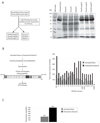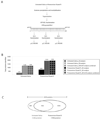A dynamic range compression and three-dimensional peptide fractionation analysis platform expands proteome coverage and the diagnostic potential of whole saliva
- PMID: 19813771
- PMCID: PMC2789208
- DOI: 10.1021/pr900675w
A dynamic range compression and three-dimensional peptide fractionation analysis platform expands proteome coverage and the diagnostic potential of whole saliva
Abstract
Comprehensive identification of proteins in whole human saliva is critical for appreciating its full diagnostic potential. However, this is challenged by the large dynamic range of protein abundance within the fluid. To address this problem, we used an analysis platform that coupled hexapeptide libraries for dynamic range compression (DRC) with three-dimensional (3D) peptide fractionation. Our approach identified 2340 proteins in whole saliva and represents the largest saliva proteomic dataset generated using a single analysis platform. Three-dimensional peptide fractionation involving sequential steps of preparative isoelectric focusing (IEF), strong cation exchange, and capillary reversed-phase liquid chromatography was essential for maximizing gains from DRC. Compared to saliva not treated with hexapeptide libraries, DRC substantially increased identified proteins across physicochemical and functional categories. Approximately 20% of total salivary proteins are also seen in plasma, and proteins in both fluids show comparable functional diversity and disease-linkage. However, for a subset of diseases, saliva has higher apparent diagnostic potential. These results expand the potential for whole saliva in health monitoring/diagnostics and provide a general platform for improving proteomic coverage of complex biological samples.
Figures





References
-
- Zhang H, et al. Mass spectrometric detection of tissue proteins in plasma. Mol Cell Proteomics. 2007;6(1):64–71. - PubMed
-
- Defabianis P, Re F. [The role of saliva in maintaining oral health] Minerva Stomatol. 2003;52(6):301–308. - PubMed
-
- Humphrey SP, Williamson RT. A review of saliva: normal composition, flow, and function. J Prosthet Dent. 2001;85(2):162–169. - PubMed
-
- Turner RJ, Sugiya H. Understanding salivary fluid and protein secretion. Oral Dis. 2002;8(1):3–11. - PubMed
Publication types
MeSH terms
Substances
Grants and funding
LinkOut - more resources
Full Text Sources

